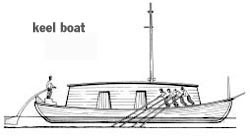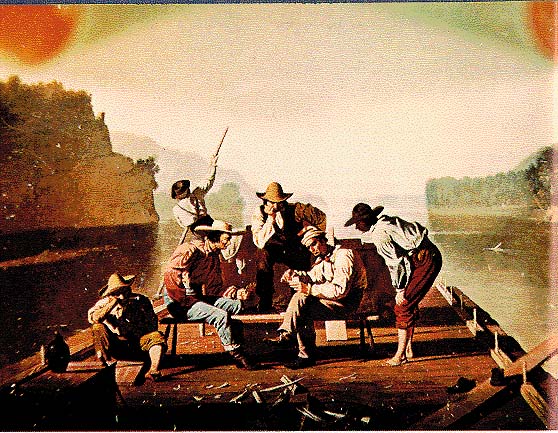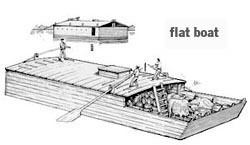 Riverboats and the early ferry operations
Riverboats and the early ferry operations Riverboats and the early ferry operations
Riverboats and the early ferry operations |
The first ferries crossing from Piggott's complex to St. Louis were pirogues, small boats similar to canoes, made from hollowed out logs. Requiring people to paddle or pole them across the river, the pirogues were slow and could carry only a few people and a small amount of goods. Large items like horses and barrels were placed on platforms lashed on top of two pirogues. This form of transportation served for the twenty years between 1795 and 1815, at which time John McKnight and Thomas Brady, two St. Louis merchants, purchased part of the Piggott ferry operation.
Between 1815 and 1820 the McKnight-Brady Ferry used keel boats. Traveler Edwin Draper described the crossing in 1815.
 |
| George Caleb Bingham - "Raftsmen Playing Cards" (1847; St. Louis Art Museum) |
"The ferry boat on which we crossed was a small keel boat, without upperdeck or cabin, and was propelled by four oars by hand. The wagons, then the only means of land travel, were run by hand on to the boat, across which were placed broad planks transversely, resting on the gunwales of the boat, while the tongue of the wagon projected beyond the side of the boat...The horses, wagon, and, saddle, family, slaves, and dogs were stowed in the bottom of the boat between the wagons."In 1820 the McKnight-Brady company changed boats again, this time to team-boat ferries that worked using a horse treadmill to turn one or more paddle wheels. This technological innovation helped the McKnight-Brady Ferry secure more business than the smaller Cahokia ferry or than John Anthony, who rented out boats to people wanting to cross the river north of the McKnight-Brady operation.

The Mississippi River was not easily navigated until well into the nineteenth century. Before the government launched an intensive effort to clear the river for the passage of steamboats, most people relied on keel boats such as the one pictured above or flat boats, large flatbottomed boats steered from the rear and primarily employed to travel downstream with the currents.
The basis of the ferry operation between St. Louis and Illinois consisted of supplying St. Louis with agricultural products and transporting immigrants heading west to the new territory acquired from Spain in the 1803 Louisiana Purchase. St. Louis relied on the American Bottoms region for most of its foodstuffs and materials.